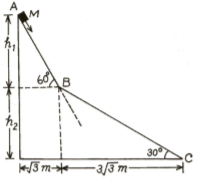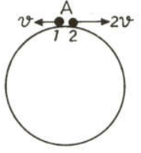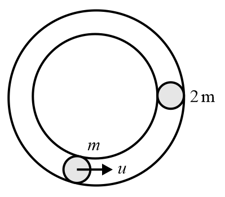Elastic and Inelastic Collisions
Elastic and Inelastic Collisions: Overview
This topic covers concepts such as Collisions, Inelastic Collision, Elastic Collision, Head-On and Oblique Collisions, Perfectly Inelastic Collision, Head-On Elastic Collision, Linear Momentum and Collisions, Mechanical Energy in Collisions, etc.
Important Questions on Elastic and Inelastic Collisions
Which one of the following is true for an elastic collision between two bodies?
A heavy truck moving with a velocity of collides with a light drum at rest. If the collision be elastic, then velocity of drum immediately after the collision will be
A bullet is fired from a rifle and the rifle recoils. Kinetic energy of rifle is
In elastic collision, energy transfer takes place when
A proton of mass m collides elastically with a particle of unknown mass at rest. After the collision the proton and the unknown particle are seen moving at an angle of with respect to each other. The mass of unknown particle is
In a collinear collision, a particle with an initial speed strikes a stationary particle of the same mass. If the final total energy is greater than original kinetic energy. The relative velocity between the two particles, after collision is
If the collision between the block and the incline is completely elastic, then the vertical (upward) component of the velocity of the block at point immediately aafter it strike the second incline is
A small block of mass moves on a frictionless surface of an inclined plane, as shown in the figure. The angle of the incline suddenly changes from to at point B. The block is initially at rest at A. Assume that collisions between the block and incline are totally inelastic. . 
A block of mass is moving with a speed of on a smooth surface. It strikes another mass of and then they move together as a single body. The energy loss during the collision is:
Two small particles of equal masses start moving in opposite directions from a point in a horizontal circular orbit. Their tangential velocities are and , respectively, as shown in the figure. Between collisions, the particles move with constant speeds. After making how many collisions, other than that at , these two particles will again reach the point ?

A smooth sphere is moving on a frictionless horizontal plane with angular speed and centre-of- mass velocity . It collides elastically and head-on with an identical sphere at rest. Neglect friction everywhere. After collision, their angular speeds are and respectively. Then:
Consider a rubber ball freely falling from a high height on to a horizontal elastic plate. Assume that the duration of collision is negligible and the collision with the plate is totally elastic. Then the velocity as a function of time and the height as a function of time will be:
Two particles of masses and , in projectile motions, have velocities respectively at . They collide at time . The velocities become and at time while moving in air. The value of is
A point mass of collides elastically with a stationary point mass of . After their collision, the mass reverses its direction and moves with a speed of . Which of the following statements is correct for a system of these two masses?
Two objects of the same mass and with the same initial speed, moving in a horizontal plane, collide and move away together at half their initial speeds after the collision. The angle between the initial velocities of the objects is,
Two masses and are placed in a fixed horizontal circular smooth hollow tube as shown. The mass is moving with speed and the mass is stationary. After their first collision, the time elapsed for next collision is (Coefficient of restitution is, )

In perfectly inelastic collisions, the relative velocity of the bodies:
A particle of mass and velocity collides head-on with a stationary particle of mass . After collision the velocity of both particles is . The energy lost in the collision is:
A proton of mass a.m.u. collides with a Carbon- nucleus (mass = a.m.u.) at rest. Assuming that the collision is perfectly elastic and that the Newton's laws of motion hold, what fraction of the proton's kinetic energy is transferred to the Carbon nucleus ?
A metal ball falls from a height of on to a steel plate and jumps up to a height of . The coefficient of restitution of the ball and steel plate is
